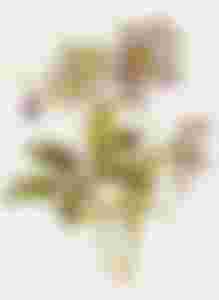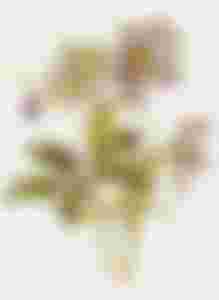Kukurek healed heroes, poisoned emperors and won wars. According to beliefs, it has magical and healing properties, and although its flowers are beautiful and large, and they really represent the first newspapers of spring, no one mentions it for such beautiful features ... Would you give a loved one a bouquet of the first porcupines? People somehow opt more for violets and visibabes, and not without reason, because we remember this plant, which entered many ancient legends through a small door, not for its beautiful flowers, but for its strong poisons.Kukurek is one of the first "messengers" of the new spring. It blooms already in January or February, depending on the climate. It is a perennial plant up to 60 cm high, with beautiful large flowers of green, purple, white or pink color.
It inhabits forest areas and is very common so it can easily be found in forests around cities and settlements. Even in the middle of winter if there is not much snow we can discover a place where a new flower stalk will emerge because many species of corn have so-called ground leaves that are evergreen and while the flower stalk withers and rots the ground leaves stoically endure winds and snow and stay green throughout winter. . The ground leaves have a long stalk, on the upper part of which there are palm-shaped narrow and long leaves, so that the whole leaf looks like a small dark green palm tree that protrudes under the snow. In addition to these "palms", new stalks and flowers of corn will sprout in February.

And although it is one of the first spring plants, cornflower simply never enters that well-known "set" of spring plants, which includes visibabe, violets, saffron and hyacinths. A person simply does not have the habit of giving a bouquet of corn to a loved one, for example! And such a gift would probably be understood by some as an insult. People have always been wary of this beautiful and attractive plant, and of course there is a justification for that - because corn is better known for its poisonous nature than for its attractive appearance. The main reason for that is several chemical poisons that are found in the tree and rhizome of this plant. These poisons are not at all naive and in some species of corn, which fortunately do not grow in our country, they are so strong that they can lead to severe disorders and even death. It is known that cows or sheep that inadvertently eat corn on the pasture can become seriously ill.The healing and poisonous properties of corn have been known since ancient times. The scientific name for corn is Helleborus, and it comes from the Greek word "heleboros". Under that name, the Greeks meant both corn and a completely different plant called hellebore (genus Veratrum). Kukurek was called black heleboros and čemerika white heleboros. Some believe that the word heleboros means bad food or poisonous food, but there are also those who think that heleboros means food for goats or food for deer. The latter link their interpretations to the allegations that epilepsy was treated by patients drinking the milk of goats fed corn.
Judging by old records and legends, corn was a very important plant of ancient times, especially because of its poisonous and healing properties. The ancient Greeks used it in the treatment of madness and madness, as well as in very efficient and fast poisoning of the enemy. The main toxins of corn are helleborin, helebrin and helleborein, and they are also responsible for the deadly reputation of this plant.According to one legend, Melampod from Pila, who knew a dumb language, cured the daughters of King Preto from the madness that overwhelmed them precisely thanks to the medicine he made from corn. In exchange for the medicine, he asked for and received a third of the kingdom of Argolis.
Hercules (Hercules), an ancient hero, when he went mad from time to time, was also cured thanks to corn. He was cured by Antikiros, who made a medicine from a very poisonous black corn (Helleborus niger). Thanks to Heracles' healing, Antikiros became a very famous healer, and the settlement in the vicinity of which the black corn grew was named Antikira after him.
But corn, as it brings healing, can cause death in an even easier way. Some historians believe that Alexander the Great died from an overdose of corn, which he took as a medicine for a long time. The case of the first chemical war in the history of European civilization, which was fought with corn, is also known! According to legend, the Phocians of the city of Cyrus intercepted and plundered pilgrims going to Delphi for years. The Delphi rebelled against that, and after a couple of years of "fighting" and quarreling, a war known as the First Holy War began. It lasted for 10 years (585 to 595 BC) and finally the Phocians were defeated by the warriors who defended Delphi poisoning their water with corn, and that was the one brought from Antikyra! The soldiers drank that water and all of them got sick from stomach problems and heart arrhythmias, because corn poisons mostly disturb the work of the heart, so they were not able to fight further and their city of Kira was finally conquered.One of the most famous and most widely used species of corn is the one for which Antikira became famous - black corn (Helleborus niger). It is extremely poisonous but also very suitable for creating various hybrid species that are grown in gardens.
So today there are various varieties of garden corn that only slightly resemble the "original". They are less poisonous and have much nicer and larger flowers. Kukurek is especially popular with gardeners because it blooms even in January when the gardens are usually deserted and cold. Precisely because of its great resistance to frost and winter and flowering in the middle of winter, when the time is not right, black corn is also known as the Christmas rose, because in England some varieties bloom at the end of December, ie. somewhere around Catholic Christmas.
According to one legend, the corn called the Christmas rose is of angelic origin and originated 2000 years ago when a girl named Madelon came to Bethlehem to greet the newborn Jesus, but when she saw the gold, incense and myrtle (myrrh) brought by the three Sages to gift to Jesus, she was very sad because, unlike them, she had nothing to give him. Then the angel saw the weeping girl, came to her and touched the ground with her wings, and at the place of that touch, large white flowers of a Christmas rose sprang up, which Madelon picked and gave to the newborn god.
It is well known among our people that corn is both a poisonous and medicinal plant, and it has often been given various magical properties. According to Veselin Cajkanovic, they put corn roots in water and sprayed children with them on holidays. It was used as a medicinal herb and was traditionally picked on Biljana Friday (Friday before St. George's Day) and on Cveti (the week before Easter). It is believed that corn brought misfortune if it is brought into the house before St. George's Day, and if it is brought on St. George's Day, then it will protect the house from sorcery and evil eyes.
Cajkanovic states that in some parts, children sing the magic song "Kukurek from the hill calls: marry me!" A beautiful rose extends its hand: take me! ”
The corn belongs to the Ranunculaceae family, and includes about 20 species that mainly inhabit Europe and the Mediterranean, and the largest number of species is found in the Balkans.
Tibetan corn (Helleborus thibetanus) grows in Tibet.
In our country, 4 species of corn are known, of which the most common is the fragrant corn Helleborus odorus. Helleborus serbicus, or Serbian corn, is an endemic species that grows only in Serbia.
Black corn or Christmas rose Helleborus niger, which is extremely poisonous and whose use leads to heart disorders and often death does not grow in Serbia

Great post